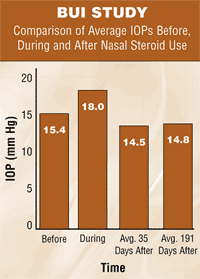Discontinuing steroid nasal spray may lower IOP
The cessation of nasal steroid treatment in glaucoma patients may result in a significant decrease in intraocular pressure, according to a study conducted at the Vanderbilt Eye Institute.
The study, authored by Christina Bui, MD, and colleagues, was published in the November 2005 issue of the Journal of Allergy and Clinical Ophthalmology.
Topical, parenteral steroids increase IOP
According to the study abstract, other studies have shown that topical, intraocular, oral and parenteral steroids may increase intraocular pressure, but little is known about the impact of nasal steroids on IOP.
This study, therefore, aimed to look at the effect of discontinuing nasal steroid sprays on the IOP of previously well-controlled glaucoma patients. The researchers performed a retrospective chart review of patients with glaucoma who were using nasal steroids. Average IOP for these patients was measured at four different points: presteroid use, during steroid use and in two consecutive exams post-steroid use. Twenty-four eyes of 12 patients taking nasal steroids were identified.
IOP increase, then decrease

According to the results, the average IOP for each pair of eyes was 15.4 ± 4.3 mm Hg (range, 9 to 23.5 mm Hg) for the presteroid use examination, 18.0 ± 3.8 mm Hg (range, 12 to 24.5 mm Hg) for the steroid use examination, 14.5 ± 3.3 mm Hg (range, 95 to 22.0 mm Hg for post-steroid use exam 1 and 14.8 ± 3.4 mm Hg (range, 95 to 22.0 mm Hg) for post-steroid exam 2.
Eleven patients experienced decreased average IOP at post-steroid exam 1 after the steroid spray was discontinued at a mean of 35 ± 14 days. These patients maintained this decrease at the post-steroid exam 2 visit at a mean of 191 ± 150 days.
A significant increase occurred between presteroid and steroid use exam IOPs (p=0.007), and a significant reduction occurred between steroid use and both post-steroid use exam IOPs.
No noteworthy difference was observed between presteroid use and either post-steroid use IOPs (p=1.00). Several patients achieved target pressures and were able to avoid or postpone further glaucoma therapy.
The study concluded that nasal steroids are a possible contributing factor to IOP increases in glaucoma patients. Practitioners are, therefore, advised to ask about a patient’s glaucoma status prior to initiating nasal steroid therapy.
For more information:
- Christina Bui, MD, is a third-year resident at Vanderbilt Eye Institute. She can be reached at 8000 Medical Center East, Nashville, TN 37232-8808; (615) 936-2020; fax: (615) 936-1540.
Reference:
- Bui CM, Chen H, Shyr Y, Joos KM. Discontinuing nasal steroids might lower intraocular pressure in glaucoma. J Allergy Clin Immunol. 2005;116(5):1042-1047.
